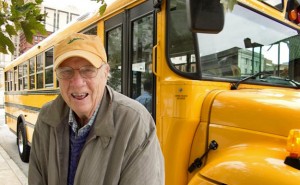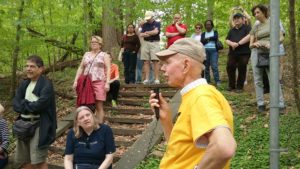 Our private group tours are a perfect way to explore Baltimore, discover hidden landmarks and enjoy unique stories from over 200 years of local history.
Our private group tours are a perfect way to explore Baltimore, discover hidden landmarks and enjoy unique stories from over 200 years of local history.
Let us know if we can host a tour for your professional meeting, academic conference, family reunion, or any other occasion. And don’t forget – visitors are always welcome on any of our events, check out our calendar here.
Walking Tours

Bring your school group, book club, or office on a private tour with us! We can tailor many tours from 1-2 hours in length. Many offerings can be adapted for 45-min office lunch or happy hour tours. One-hour tours are $125 and two-hour tours are $200.
Please contact Molly Ricks at ricks@baltimoreheritage.org or 240-305-3984 for more information about scheduling a walking tour for your private group.
Our Tour Offerings
Downtown Tours
Charles Center and the Historic West Side of Downtown: Historic downtown along Howard, Eutaw and Baltimore Streets has some of the finest cast iron buildings in the country. It also has the bar that Babe Ruth’s father owned and where the young Babe spent a little more time growing up than maybe was good for him. From straw hats to harlequins, from hops to harpsichords, the West Side is teaming with history.
The New Lexington Market & Exploring the Neighborhood Around It: For over 200 years, Lexington Market’s wooden sheds and concrete stalls have been a gathering place for Baltimoreans. And the market is still evolving! In October 2022, the new Lexington Market opened in a brand new building. On this tour we’ll first explore the surrounding neighborhood to discover how Baltimore emerged as a leading industrial and economic city in the 19th century. Immigration, slavery, commerce, and major changes in transportation were all part of the mix here in Baltimore and the country as a whole. And in the 1940s and 1950s, this area was a hub of Civil Rights activism. We’ll end at the new market to see its wonderful public art and, of course, its merchants (new and old).
Federal Hill: Join us on a tour of Federal Hill and the surrounding neighborhood to learn about this waterfront community’s rich history, including stops at one of the last wooden houses in the city, the oldest house in Federal Hill, and of course, the hill we fortified to defend the city from the British in the War of 1812.
Green Mount Cemetery: Opened in 1839, Green Mount is an early example of an urban-rural cemetery, that is, a cemetery with a park-like setting located close to the countryside. Green Mount is the final resting place of some of Maryland’s most famous, and infamous, figures including Johns Hopkins, Enoch Pratt, William and Henry Walters, Mary Elizabeth Garrett, Betsy Patterson, A.S. Abell, John H. B. Latrobe, John Wilkes Booth, and Elijah Bond, who patented the Ouija Board!
Historic Jonestown and the Shot Tower: Anchored by the Phoenix Shot Tower, Historic Jonestown is one of the oldest neighborhoods in the city and includes often overlooked landmarks. In addition to going inside the Shot Tower, on this tour you’ll learn about the city’s oldest religious building (Friends Meeting House) and the third oldest synagogue in the country (Lloyd Street Synagogue), and the longest-lived signer of the Declaration of Independence, Charles Carroll.
Out of the Ashes: Baltimore and the Great 1904 Fire: In 1904, a fire swept through downtown Baltimore destroying 1500 buildings, causing $150 million in damage, and leaving 35,000 people unemployed. Baltimore was determined to rebuild and this effort is at the heart of how downtown looks and functions today. Join us to learn about the fire and how it shaped the Baltimore we know today.
Historic Ridgely’s Delight: For a diminutive neighborhood squeezed between the University of Maryland and Camden Yards, Ridgely’s Delight contains a supremely oversized history. Babe Ruth was born here, and George Washington rode here. Join us as we stroll through this charming community (one of the oldest neighborhoods in Baltimore!) and learn about some of its rich heritage.
Feisty Females of Fells Point: Everyone knows that this neighborhood has a rich history, but do you know about the Caribbean immigrant, Mary Lange, who dared to teach children of color out of her home and rose to be the first Black mother-superior in American history? How about the single mom who helped stop the development of an interstate highway through these historic streets? Spoiler–it’s not Barbara Mikulski, but of course we’ll talk about her important work too. And we’ll stop by the former rowhouse of someone else you might know–Billie Holiday. We hope you’ll join us to hear about these fierce women who helped forge Fells Point into the vibrant, distinctive neighborhood it is today.
Mount Vernon Cultural District Tours
LGBTQ History in Mt. Vernon: Mount Vernon, with its nineteenth century homes, many of the city’s cultural institutions, and its own literary history, has also long been regarded as Baltimore’s gayborhood. In our walk, we’ll learn about pioneering lesbian women who helped shape Baltimore’s educational institutions, medical professionals who were on the front lines of the AIDS epidemic, and residents who founded Baltimore’s first black LGBTQ church. Join us to see how Baltimore’s LGBTQ community has been an integral part of the neighborhood’s history.
Mt. Vernon: Cradle of American Philanthropy: From its country beginnings as Revolutionary War hero John Eager Howard’s estate, the Mount Vernon neighborhood grew up as the place to live for Baltimore’s rich and famous in the 19th century. The Garretts, owners of the B&O Railroad and the Walters, founder of the Walters Art Museum, are among the families that built handsome mansions near the Washington Monument. Join us on a stroll to learn about fascinating history and current revitalization happening in this grand historic district.
Heritage Exploration Tours
Baltimore’s Civil Rights Heritage: Baltimore’s diminutive Marble Hill neighborhood gave rise to some of the fundamental pillars of the Civil Rights Movement like Thurgood Marshall, Lillie Carroll Jackson, and Clarence Mitchell. Learn about Baltimore’s significant contribution to the Civil Rights Movement here in this cauldron of intellectual and activist leaders known as Marble Hill.
Industry and Artistry at Station North: Our tour will take in 100 years of industry and innovation: the historic theaters, schools, markets, and factories that make the Station North Arts and Entertainment District a current hot spot of arts and culture. In the first few decades of the 20th century, the inventor of the modern bottle cap built his factory on Guilford Avenue and entrepreneurs on Charles Street pushed the theater business in new directions.
LGBTQ Heritage in Charles Village: Although Charles Village is better known for its colorful “painted ladies,” the neighborhood was home to many activists and institutions at the heart of the city’s LGBT community in the 1970s and 1980s. We will walk past local landmarks including the original home of the Gay Community Center of Baltimore and the St. Paul Street church that supported the growth of the Metropolitan Community Church, Baltimore’s oldest LGBTQ religious organization.
